Recombinant Human CKB protein, His-tagged
| Cat.No. : | CKB-495H |
| Product Overview : | Recombinant Human CKB protein(P12277)(Pro2-Lys381) was expressed in Insect Cells, fused with a polyhistide tag at the N-terminus. |
- Specification
- Gene Information
- Related Products
- Citation
- Case Study
- Application
- Download
| Species : | Human |
| Source : | Insect Cells |
| Tag : | His |
| Protein Length : | 2-281 a.a. |
| Tag : | N-His |
| Form : | Supplied as sterile 50mM Tris, 100mM NaCl, 10% glycerol, pH 8.0. |
| Molecular Mass : | The recombinant human CKB consists of 398 amino acids and has a calculated molecular mass of 44.8 kDa. The recombinant protein migrates as an approximately 45 kDa band in SDS-PAGE under reducing conditions. |
| Endotoxin : | < 1.0 EU per μg of the protein as determined by the LAL method |
| Purity : | > 90 % as determined by SDS-PAGE |
| Storage : | Samples are stable for up to twelve months from date of receipt at -20°C to -80°C. Store it under sterile conditions at -20°C to -80°C. It is recommended that the protein be aliquoted for optimal storage. Avoid repeated freeze-thaw cycles. |
| Reconstitution : | It is recommended that sterile water be added to the vial to prepare a stock solution of 0.2 ug/ul. Centrifuge the vial at 4°C before opening to recover the entire contents. |
| Publications : |
CKB inhibits epithelial-mesenchymal transition and prostate cancer progression by sequestering and inhibiting AKT activation (2021)
|
| Gene Name | CKB creatine kinase, brain [ Homo sapiens ] |
| Official Symbol | CKB |
| Synonyms | CKB; creatine kinase, brain; CKBB; creatine kinase B-type; creatine kinase-B; creatine kinase B chain; B-CK |
| Gene ID | 1152 |
| mRNA Refseq | NM_001823 |
| Protein Refseq | NP_001814 |
| MIM | 123280 |
| UniProt ID | P12277 |
| ◆ Recombinant Proteins | ||
| CKB-344H | Recombinant Human CKB protein, His-tagged | +Inquiry |
| Ckb-2129R | Recombinant Rat Ckb protein, His-tagged | +Inquiry |
| CKB-792H | Recombinant Human CKB Protein, His-tagged | +Inquiry |
| CKB-607H | Recombinant Human CKB Protein, His (Fc)-Avi-tagged | +Inquiry |
| CKB-3494M | Recombinant Mouse CKB Protein | +Inquiry |
| ◆ Native Proteins | ||
| CKB-8079H | Active Native Human CKB protein | +Inquiry |
| CKB-46M | Native Mouse Creatine Kinase, Brain (CKB) Protein | +Inquiry |
| CKB-1177H | Native Human Creatine Kinase, Brain | +Inquiry |
| ◆ Cell & Tissue Lysates | ||
| CKB-001HCL | Recombinant Human CKB cell lysate | +Inquiry |
CKB inhibits epithelial-mesenchymal transition and prostate cancer progression by sequestering and inhibiting AKT activation
Journal: Neoplasia (New York, N.Y.) PubMed ID: 34706306 Data: 2021/10/24
Authors: Zheng Wang, Mohit Hulsurkar, Wenliang Li
Article Snippet:Protein samples together with anti-AKT antibody (#2920, Cell Signaling Technology), anti-Rictor antibody (#051471, Millipore sigma) or mouse IgG isotype control antibody (#5415, Cell Signaling Technology) were incubated at 4°C overnight.Protein samples together with anti-AKT antibody (#2920, Cell Signaling Technology), anti-Rictor antibody (#051471, Millipore sigma) or mouse IgG isotype control antibody (#5415, Cell Signaling Technology) were incubated at 4°C overnight.. To detect direct interaction of AKT and CKB in vitro, 2ug purified his-AKT1 (#PR3878D, Invitrogen) and his-CKB (#495H, Creative BioMart) were incubated at 4°C for 2h.. Equal amount of anti-CKB antibody (#ab108388, Abcam) and rabbit IgG isotype control antibody (#3900, Cell Signaling Technology) were added for binding at 4°C overnight.Equal amount of anti-CKB antibody (#ab108388, Abcam) and rabbit IgG isotype control antibody (#3900, Cell Signaling Technology) were added for binding at 4°C overnight.
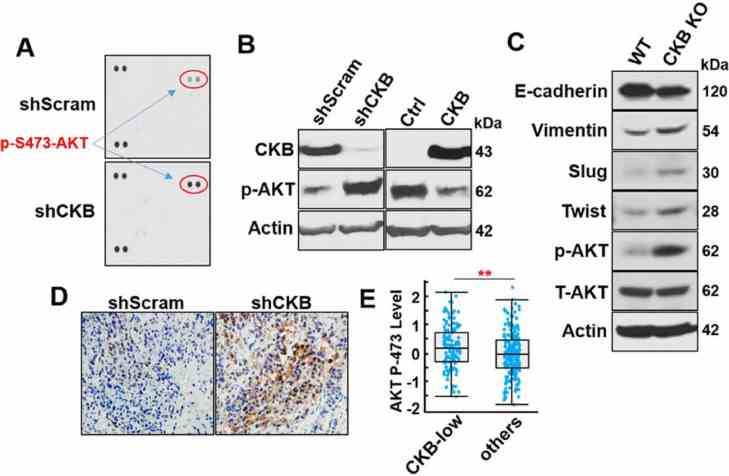
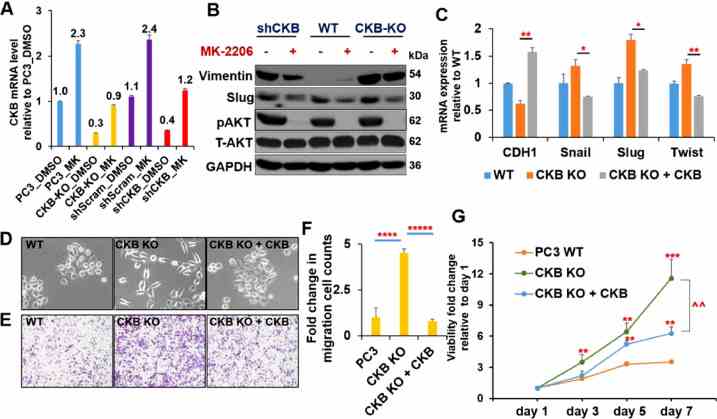
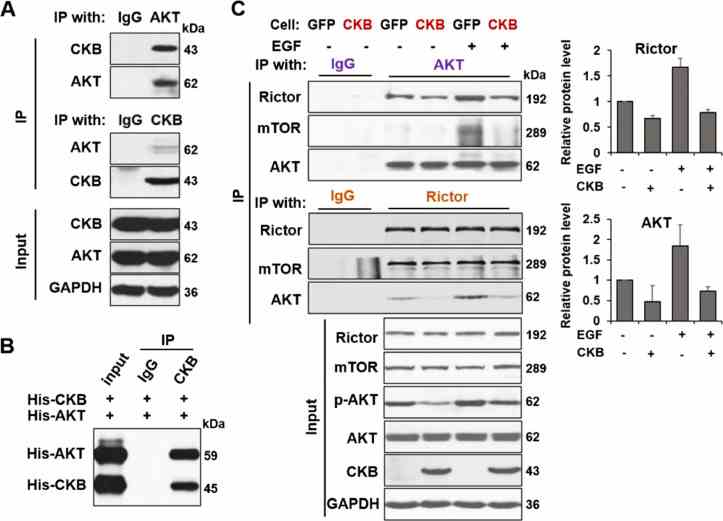
Case 1: Wang Z, et al. Neoplasia. 2021
EMT aids cancer spread and resistance, with AKT being crucial. Typically, there's a lack of inhibitors, but brain-type creatine kinase (CKB) has emerged as a suppressor. While normally present, CKB decreases in some cancers, leading to worse outcomes. When CKB is boosted, EMT and cancer movement lessen; when reduced, cancer activity spikes. CKB blocks AKT activation by binding to part of it, and even just an 84aa fragment of CKB can slow AKT, EMT, and cancer cell growth.
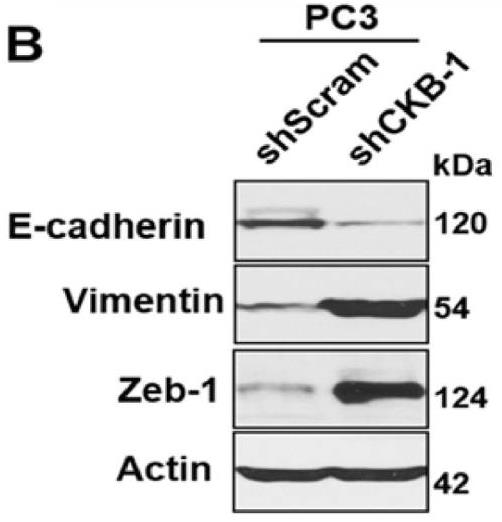
Fig1. Immunoblotting of whole cell lysates of PC3 cells stably expressing scramble control shRNA or CKB shRNA.

Fig2. Immunoblotting for p-S473-AKT, CKB and Beta Actin in DU145 cells.
Case 2: Rahbani JF, et al. Nature. 2021
Obesity brings higher risks for diseases like diabetes and heart issues. But adipocytes, through heat production, can help tackle obesity. In this process, creatine helps mitochondria make heat, but researchers didn't know which proteins handled this. It turns out creatine kinase B (CKB) is key, moving to mitochondria to do its job. When CKB kicks in, it’s triggered by heat in both mice and humans. If mice lack CKB in fat cells, they can't produce as much heat, gain weight easier, and struggle with glucose control. So, CKB is essential in this energy-burning cycle.
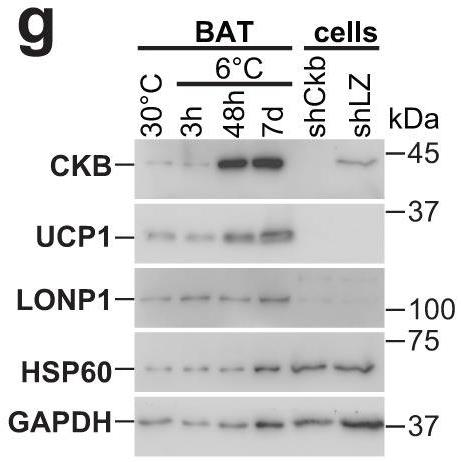
Fig1. Western blot of BAT from wild-type (C57BL6/N, 6-8 weeks old) male mice.
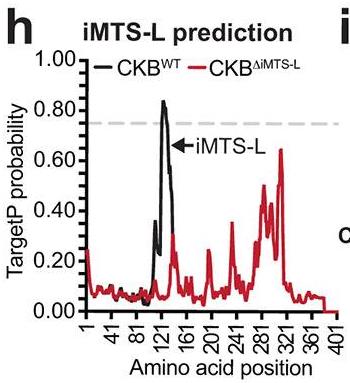
Fig2. TargetP probability plotted along the CKB amino acid sequence.
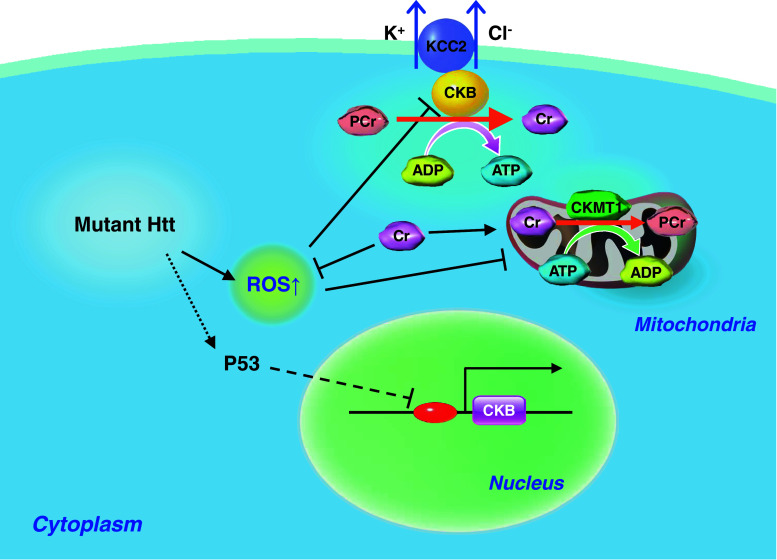
Fig1. Regulation of brain-type creatine kinase (CKB) in Huntington’s disease (HD). (Tz-Chuen Ju, 2012)
Not For Human Consumption!
Inquiry
- Reviews (0)
- Q&As (0)
Ask a Question for All CKB Products
Required fields are marked with *
My Review for All CKB Products
Required fields are marked with *



